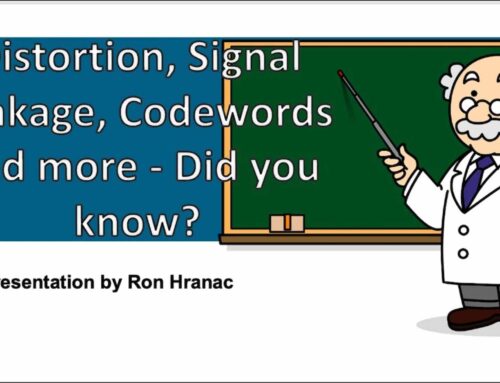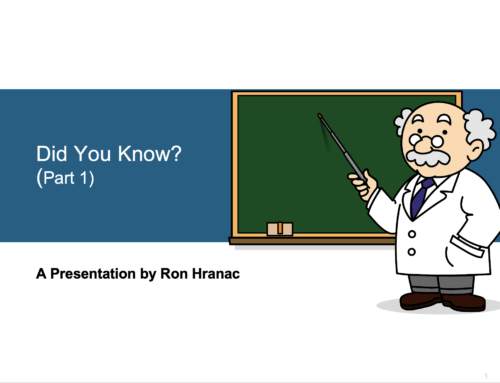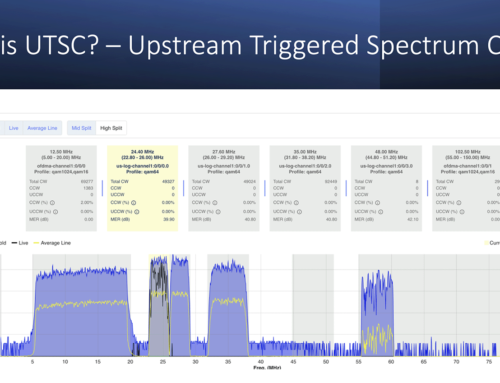DOCSIS & Testing Best Practices in an All Digital Network
ANGACOM – 2013
Missed ANGACOM 2013? Don’t worry, you can still see the presentation on DOCSIS & Testing Best Practices in an All Digital Network along with the speaker notes for each slide. This was only a 15 minute presentation, so time was limited on the depth of material that could be covered in the time given.
Slide 2 – Overview
What do I mean by all digital networks and why is the cable industry moving in this direction? Simple. Our subscribers, our customers want one thing – lots of content. This content may be video or data, but in the end they often get it from the same place; the Internet. We like to think that we, as cable operators will control the source of video content, but more and more our subscribers are determining where they will get the content from.
This means we are seeing rapid data growth on our DOCSIS networks. So rapid that experts predict we will need 1 gigabit per second in the downstream and upstream within the next five years. For the downstream that means over 20 QAM channels dedicated to DOCSIS alone. This displaces many existing video QAM channels. It means that we must convert analog channels to QAM channels in order to still offer the same channel lineup. This is analog reclamation and I am sure that many of you are already in the process of doing this or are making plans to do it. By doing so it will have impacts on how we manage and operate our networks moving forward.
Slide 3 – Benefits of Digital over Analog
Just so we are all on the same page, let us recap the benefits of migrating from analog to digital. By this I mean changing from a Phase Alternating Line or PAL channel, which can transport one video channel at 576i definition to DVB-C J.83 Annex A channel, which can transport up to six high-definition channels at 256-QAM or typically 10 standard definition television channels in 64-QAM and 20 channels in 256-QAM, depending upon they type of compression used. More channels are possible with high levels of compression.
Digital channels also makes encryption and re-mapping of television stations much easier. This is especially true when taking advantage of the latest edqe QAM technologies coupled with digital video solutions. Professional TV Guides can easily be provided to your subscribers on their settop boxes giving them a wide range of interactivity not previously available, especially when taking advantage of DOCSIS-enabled set top boxes, called DSG for DOCSIS set-top gateway.
Understandingly, there are governmental requirements for most countries on must-carry analog channels. These you will be required to carry until such a time that the laws are changed. This is something that we should lobby for, as analog channels are not an effective use of the RF spectrum. In the long run all-digital networks will better sever our subscribers for the same reasons that terrestrial broadcasts have migrated to all-digital.
In summary, migrating from analog buys you more channels per Hertz, additional security from theft-of-service, and new features for your subscribers. This is a win-win scenario if you look at the return on investment over the long term.
Side 4 – Headend Best Practices
As we migrate our headend to all-digital we should consider some best practices.
One of the first that I recommend is separate services. The services that I am referring to are analog, digital video and DOCSIS. In most headends amplification is required to overcome combining networks in order to have enough input level at the forward path transmitters. As we will see on upcoming slides, digital and analog signals create different distortions. Since we want to transmit very clean signals from the headend it is a best practice to separately amplify analog and digital signals so that any distortion products created by these are not introduced by the headend. So a simple best practice is to simply use separate amplifiers for digital video and analog video signals and then combine them after the amplifiers.
While on the topic of amplifiers, I always recommend redundant amplifiers in headends. A number of manufacturers make these. They work by sensing when one the output of an amplifier has no signal or if the signal falls in level by 3 dB at which time the amplifier switches over to the standby unit. If a redundant amplifier is not within your budget, I would recommend ones that have spare power supplies. The power supply is typically the weak link in any device. So a spare power supply in your headend amplifiers will often keep you running.
I do recommend not amplifying DOCSIS signals at all. If you are providing VoIP and assume that your subscribers use data for business and many critical communications like email, texting, Facebook and Twitter – these are the most two important of them all, then you want to reduce as many single points of failure as possible, starting with headend amplifiers. Also, if you have any type of automatic gain control amplifiers in your network that require a pilot signal or use digital signals as the pilot signal it is import to ensure that these signals remain online while the DOCSIS channels are online. If you lose your AGC pilot signals then the gain in your amplifiers will increase and cause your DOCSIS signals to become distorted. So treat your pilot signals just like your DOCSIS signals from a signal integrity standpoint.
If you have been using edge QAM devices or high-capacity cable modem termination systems you realize by now that QAM output powers are much less than single QAM devices. So be nimble and optimize your headend combining.
Finally, forward path monitoring systems are a great way to ensure that QAM signals leaving network are consistently remaining high quality and they will also notify you of any QAM outage or impairment ideally before your subscribers notice the impairment. Having a headend monitoring system will often prevent a truck roll by alerting you to the fact that the source of the problem is at the headend and not in the field.
Slide 5 – About Analog Impairments
Anyone who has spent time in a cable TV system has heard about analog distortions or has spent long hours troubleshooting them. We understand them well and know that composite second order distortion or CSO and composite triple beat or CTB and other non-linear distortions are simple mathematical products and sums of the analog carriers in a CATV network. The accumulations of these small signals result in impairments, which negatively affect the TV channels. When the impairment is great enough it becomes visible to the subscriber on both analog and digital channels. We carefully balance our plant to balance CTB and CSO with carrier to noise levels.
Slide 6 – Digital Distortions
Speaking of Carrier-to-Noise, when we add many QAM channels into our plant we see much less CTB and CSO beats and a lot more noise. But why is this? When the products and sums of QAM carriers are combined together we still get the effective results of CTB and CSO, however instead of small beats as shown on the previous slide, the beats are 8 MHz wide. Therefore they overlap each other and look like noise. This noise is lower in level than a single CTB or CSO beat, but it does accumulate to larger levels. The intermodulation of QAM signals is call composite intermodulation noise or CIN as defined by the American National Standard 17 2007.
As shown on the slide, under properly balanced conditions, CIN will often be just under the thermal noise floor. However when you use power addition to add CIN and the thermal noise floor together you end up with Carrier-to-Composite noise or CCN. Noise floor and CIN addition do follow normal 10 log addition principles, however there are some correction factors which must also be applied that are discussed in the standard. These correction factors make up for the noise-near-noise measurements that occur when measuring signals very close to the spectrum analyzer’s noise floor.
Just as in all-analog networks, all-digital networks or even networks with many digital channels, one must look at intermodulation. Now the intermodulation results in an increased noise floor. The noise floor will degrade between one to two dB as you increase RF levels, depending upon the mixture of second and third order modulations. Low frequency analog and digital channels are most likely to be negatively impacted due to plant tilt. So best practices suggest that focusing on CNR during plant balancing is critical.
Slide 7 – Sweep
Sweeping the plant is a common practice during installation and routine maintenance. In an analog plant there are abundant places for sweep carriers such that many data points can be obtained in order to see plant impairments such as standing waves, misalignment of the plant, suck-outs, and roll-off at the band edges. A requirement of many traditional sweep systems is having open space between analog carriers – that is the space between channels, and between the visual and Chroma carrier. This free space goes away in an all-digital network, however.
Slide 8 – Space Between QAM Channels
If we look closely at two QAM channels we see that there is no place to put a sweep carrier in a QAM channel. In fact the only place possible is between QAM channels, which gives us a sweep resolution of only 8 MHz steps. Imagine what can happen over the span of 8 MHz. A suck out could exist in a QAM channel, which would not be visible using tradition sweep. It is even conceivable that a standing wave could exist, but our lack of resolution would not properly present the standing wave.
Slide 9 – Some Examples
Here we see some typical examples of plant impairments that ideally need a sweep system for routine maintenance and troubleshooting as a best practice in all digital networks. The first picture on the left shows a suck-out caused by a loose center seizure screw in an RF amplifier. It completely knocks out one QAM channel and causes roll-off on the adjacent two QAM channels.
The picture on the right shows a standing wave spanning many QAM channels. This standing wave is caused by corrosion on a center seizure screw, again in an RF amplifier. The results impact the subscriber video quality displayed as macro-blocking and occasional loss of TV signal due to loss of QAM lock.
The first example would likely be seen by a tradition sweep system, but the second would be much more difficult to see using tradition sweep. What is a best practice in both examples is called sweepless sweep.
Slide 10 – Sweepless Sweep
Sweepless sweep is offered by many test equipment vendors and is now becoming a more appropriate method for sweeping systems with many QAM channels. It works by taking a reference trace or multiple reference traces in the headend. Then when out in the plant, the measured trace is compared and mathematically subtracted from the reference trace. This is a completely non-invasive method of sweeping the plant, so no blank space is needed. Therefore one has complete visibility of the forward and return spectrum for sweep up to the capabilities of the test equipment. Another benefit of a sweepless sweep system is that it does not require a headend transmitter for sweep signal injection, so it is ultimately a less complex and less expensive system.
Slide 11 – Sweepless Sweep Normalization
Here is a visualization of how sweepless sweep works when you are out in the field. The red line shows the measured trace. The green line is the reference trace stored in the meter, which is from the headend. Then the dark black line shows the difference between the location that you are measuring and the reference trace. This is where you will see plant impairments. So it is a very simple and straightforward concept.
Slide 12 – Sweepless Sweep System Problems
Here is a representation of a sweepless sweep system in practice. The dark line shows the difference trace with a number of impairments. We see band edge roll off, suck outs and a frequency response that is far from ideal. So this is an ideal solution for seeing a number of typical impairments in a non-invasive way in an all-digital plant.
Slide 13 – Digital Levels
So in an all-digital network we must not forget the importance of digital levels. These include received levels at the cable modem or setup top box as well as transmitted levels by the cable modem or DSG enabled set-top box.
Cable modems and set-top boxes like to see an ideal RF input level of 60 dBuV (db micro volts). The recommended RF input for optimal performance is 55 to 65 dBuV, which gives you +/- 5 dB of variance around the ideal. But this is not always a realistic goal in practice for installers to achieve. So the limits can be opened to worse case recommended conditions of 50 to 60 dBuV of downstream RF power at the input of the cable modem or set-top box. Now we all likely know that these devices will work well outside of these recommendation, but the question becomes how well will they work? And what will the subscriber quality of experience be once we go beyond these recommendations.
Also, an important thing to keep in mind in the downstream that while too little power can be a problem, too much RF power can also be a problem. Think about what happens when you turn up the radio in your car to its maximum volume. The speakers start to crackle. And not in a good way. The same happens when too much RF power goes into the RF input of a cable modem or set-top box. Its RF demodulator is over driven and not able to differentiate a one from a zero. So never exceed 90 dBuV of total RF power. This includes the total power of all RF channels added together on a 10 log basis.
Finally, on the upstream, the ideal transmit power to optimize carrier to noise ratio for cable modems is 100 to 110 dBuV. This is close to the maximum transmit power of the cable modem, but leaves enough headroom to accommodate changes in the RF plant. By transmitting at high RF levels in the cable modem, we are maximizing the distance of the cable modem’s signal from plant’s thermal noise floor. If we let the cable modems transmit at a lower power then their CNR will be lower and the CMTS will have greater difficulty in demodulating their signals at the receiving end.
Slide 14 – Summary
In conclusion, we can anticipate that cable networks will evolve to have more and more digital channels to support the demand for high-definition television and increasing subscriber requirements for data.
As this happens we will see the traditional non-linear distortions such as CTB and CSO be overtaken by CIN and CCN. Our testing tools will change from traditional sweep to sweepless sweep in addition to a number of new digital testing tools not covered in this presentation.
Knowledge and focus on digital levels versus analog levels becomes critical and rebalancing of plants around the digital channels becomes or has already become a standard part of our maintenance program.
One thing is certain. Cable is a growing industry. The bandwidth that can be supported over cable is huge. As we push fiber deeper out capacity expands. So it is indeed a great time to be in cable.
Previous events can be seen under the blog.
- If you are watching this on youtube please hit the subscribe button!
- Let us know what you think and remember to share!
- You can find slides at the bottom of the page and some on slideshare.
- Find out about events or articles by following us on Twitter, LinkedIn or Facebook too.
- We have stuff. Interested in buying some clothes with cable stuff. Click here
Also available on iTunes, Google Podcasts, Spotify, vurbl see podcasts “get your tech on”.





Leave a Reply